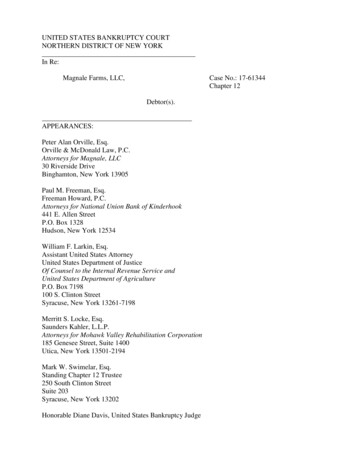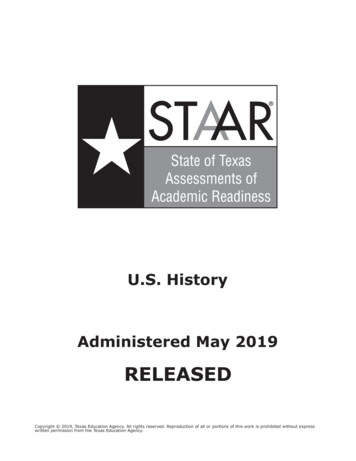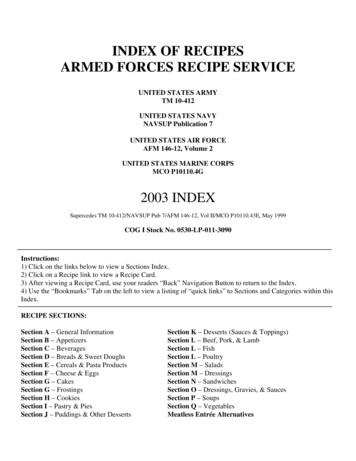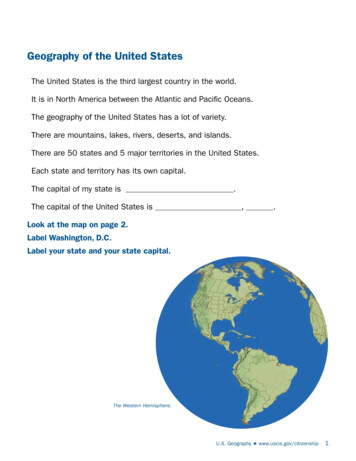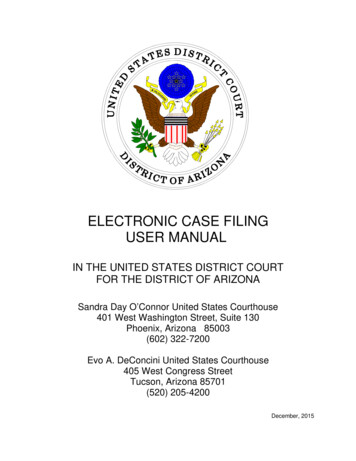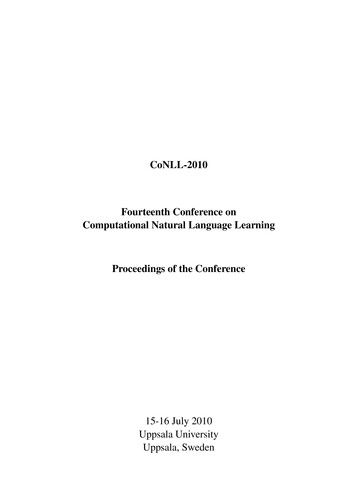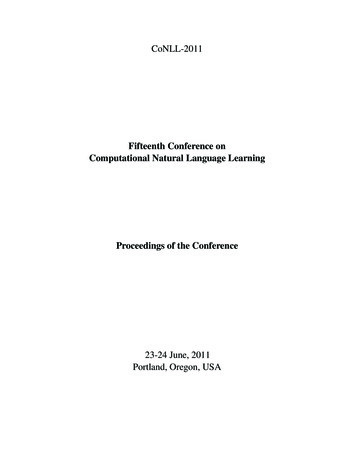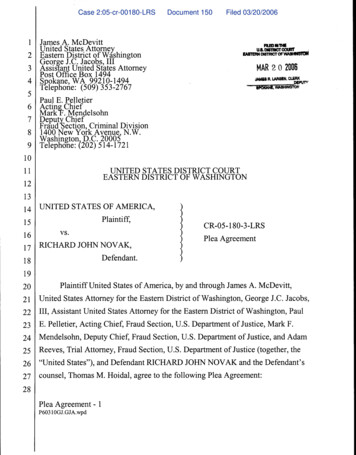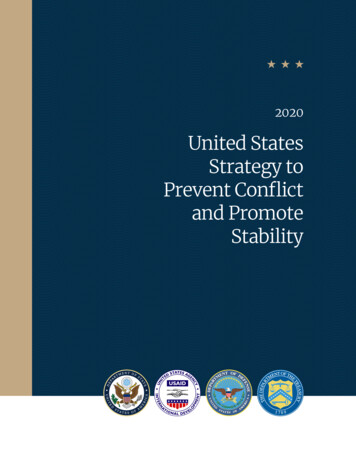
Transcription
2020United StatesStrategy toPrevent Conflictand PromoteStability
2020United StatesStrategy toPrevent Conflictand PromoteStabilityThis Strategy was submitted to Congress in line with Section 504(a)of the Global Fragility Act of 2019, which requires development of aten-year Global Fragility Strategy.
Table of ContentsEXECUTIVE SUMMARY. . . . . . . . . . . . . . . . . . . . . . . . . . . . . . . . . . . . . . . . . . . . . . . 1INTRODUCTION. . . . . . . . . . . . . . . . . . . . . . . . . . . . . . . . . . . . . . . . . . . . . . . . . . . . . . 3SECTION 1: STRATEGIC CHALLENGE. . . . . . . . . . . . . . . . . . . . . . . . . . . . . . . . . 4SECTION 2: STRATEGIC APPROACH AND GOALS. . . . . . . . . . . . . . . . . . . . 6 Goals and Objectives of the Strategy. . . . . . . . . . . . . . . . . . . . . . . . . . . . . . . . . 7Goal 1: Prevention . . . . . . . . . . . . . . . . . . . . . . . . . . . . . . . . . . . . . . . . . . . . . . . . . . 7. . . . . . . . . . . . . . . . . . . . . . . . . . . . . . . . . . . . . . . . . . . . . . . . 8Goal 3: Partnership. . . . . . . . . . . . . . . . . . . . . . . . . . . . . . . . . . . . . . . . . . . . . . . . . 9Goal 4: Management . . . . . . . . . . . . . . . . . . . . . . . . . . . . . . . . . . . . . . . . . . . . . . . 9Goal 2: StabilizationSECTION 3: ADVANCING THE STRATEGY. . . . . . . . . . . . . . . . . . . . . . . . . . . . . 11 Department and Agency Roles and Responsibilities . . . . . . . . . . . . . . . . . . . . 11 Department and Agency Decision-Making and Coordination. . . . . . . . . . . . . 12 Country and Regional Prioritization and Planning . . . . . . . . . . . . . . . . . . . . . . 13 Compact-Style Country and Regional Partnerships. . . . . . . . . . . . . . . . . . . . 14 International Cooperation and Public-Private Partnerships. . . . . . . . . . . . . . 14 Authorities, Staffing, and Resources. . . . . . . . . . . . . . . . . . . . . . . . . . . . . . . . . 15SECTION 4: STRATEGIC INTEGRATION OFUNITED STATES GOVERNMENT TOOLS AND POLICY INITIATIVES. . 16 Tools. . . . . . . . . . . . . . . . . . . . . . . . . . . . . . . . . . . . . . . . . . . . . . . . . . . . . . . . . . . 16Diplomacy . . . . . . . . . . . . . . . . . . . . . . . . . . . . . . . . . . . . . . . . . . . . . . . . . . . . . . . 16Foreign Assistance . . . . . . . . . . . . . . . . . . . . . . . . . . . . . . . . . . . . . . . . . . . . . . . . . 16Defense Support and Security Cooperation . . . . . . . . . . . . . . . . . . . . . . . . . . . . . . 17Trade, Investment, and Commercial Diplomacy . . . . . . . . . . . . . . . . . . . . . . . . . . . 18Sanctions and Other Financial Pressure Tools. . . . . . . . . . . . . . . . . . . . . . . . . . . . . 18Intelligence and Analysis. . . . . . . . . . . . . . . . . . . . . . . . . . . . . . . . . . . . . . . . . . . .19Strategic Communications. . . . . . . . . . . . . . . . . . . . . . . . . . . . . . . . . . . . . . . . . . . 19 Laws and Initiatives . . . . . . . . . . . . . . . . . . . . . . . . . . . . . . . . . . . . . . . . . . . . . . . . 19Women, Peace, and Security. . . . . . . . . . . . . . . . . . . . . . . . . . . . . . . . . . . . . . . . 20Atrocity Early Warning . . . . . . . . . . . . . . . . . . . . . . . . . . . . . . . . . . . . . . . . . . . . . 20Stabilization Assistance Review . . . . . . . . . . . . . . . . . . . . . . . . . . . . . . . . . . . . . . 20National Strategy for Counterterrorism. . . . . . . . . . . . . . . . . . . . . . . . . . . . . . . . 20SECTION 5: MEASURING SUCCESS. . . . . . . . . . . . . . . . . . . . . . . . . . . . . . . . . . . 21 Monitoring and Evaluation . . . . . . . . . . . . . . . . . . . . . . . . . . . . . . . . . . . . . . . . . . 21 Consultation, Learning, and Adaptation. . . . . . . . . . . . . . . . . . . . . . . . . . . . . . . 22
EXECUTIVE SUMMARYThe 2017 National Security Strategy (NSS) affirms that the United States will work to strengthenfragile states “where state weakness or failure would magnify threats to the American homeland”and “empower reform-minded governments, people, and civil society” in these places. The Presidentaffirmed this commitment when he signed the Global Fragility Act of 2019 (Title V of Div. J, P.L. 116-94)(GFA) into law in December 2019. This Strategy meets the law’s requirement for a “Global FragilityStrategy.”The United States Strategy to Prevent Conflict and Promote Stability seeks to break the costly cycle offragility and promote peaceful, self-reliant nations that become U.S. economic and security partners.The United States will pursue a new approach that addresses the political drivers of fragility and supportslocally driven solutions. The United States will engage selectively based on defined metrics, host countrypolitical will, respect for democracy and human rights, defined cost-sharing, and mechanisms thatpromote mutual accountability with national and local actors.This Strategy outlines four goals to guide United States efforts across priority countries and regions:Prevention: The United States will establish and support capabilities to engage in peacebuildingand anticipate and prevent violent conflict before it erupts;Stabilization: The United States will support inclusive political processes to resolve ongoingviolent conflicts, emphasizing meaningful participation of youth, women, and members offaith-based communities and marginalized groups, respect for human rights and environmentalsustainability;Partnerships: The United States will promote burden-sharing and encourage and work withpartners to create conditions for long-term regional stability and foster private sector-ledgrowth; andManagement: The United States will maximize U.S. taxpayer dollars and realize more effectiveoutcomes through better prioritization, integration, and focus on efficiency across the U.S.government and with partners.1
The United States will achieve these goals by aligning U.S. Government operations, setting clearpriorities, and integrating all tools of U.S. foreign policy: diplomacy; foreign assistance; defensesupport and security cooperation; trade and investment; sanctions and other financial pressure tools;intelligence and analysis; and strategic communications. The United States will recruit and train staffto work more effectively in fragile environments. The United States cannot and should not pursuethese efforts alone. Accordingly, this Strategy outlines a commitment to forge new partnerships withcivil society, the private sector, regional partners, and bilateral and multilateral contributors who canprovide expertise and share the financial burden.This Strategy prioritizes learning, data-driven analysis, diplomacy, and information-sharing tounderstand local dynamics, target interventions, and hold actors accountable. It lays out a clear processto systematically monitor policy outcomes, not just program outputs. If changing dynamics requirealterations in approach, if programs are not showing results, or if partners are not living up to theircommitments, the United States will change course. The success of this Strategy will require disciplineand commitment by the whole U.S. government and our partner governments, the creation of dynamicand forward-leaning country-level strategies, and flexibly and timely resources to power change.Through this new approach, the United States will seek to avoid past mistakes and better advanceAmerica’s national security interests in fragile environments.2
INTRODUCTIONThis Strategy aims to strengthen United States efforts to break the costly cycle of fragility1 and promotepeaceful, self-reliant nations that become U.S. economic and security partners. It advances the aimsof the 2017 National Security Strategy, which affirms that the United States will work to strengthenfragile states “where state weakness or failure would magnify threats to the American homeland” and“empower reform-minded governments, people, and civil society” in these places.The President affirmed this commitment when he signed the Global Fragility Act of 2019 (Title V ofDiv. J, P.L. 116-94) (GFA) into law in December 2019. The GFA calls for the United States Governmentto create a unified U.S. strategy that is intentional, cross-cutting and measurable, and harnesses thefull spectrum of United States diplomacy, assistance, and engagement over a 10-year horizon. Thegoal is to help countries move from fragility to stability and from conflict to peace. This Strategybuilds upon reforms initiated by the 2018 Stabilization Assistance Review, 2018 Elie Wiesel Genocideand Atrocities Prevention Act, 2018 National Strategy for Counterterrorism, and 2019 U.S. Strategy onWomen, Peace, and Security.Through this Strategy, the United States will pursue a different approach from previous efforts. Ratherthan externally driven nation-building, the United States will support locally driven political solutionsthat align with United States’ national security interests. Rather than fragmented and broad-basedefforts, the United States will target the political factors that drive fragility. Rather than diffuse andopen-ended efforts, the United States will engage selectively based on national interests, host-nationpolitical progress, and defined metrics. Rather than implementing a disparate set of activities, theUnited States will strategically integrate its policy, diplomatic, and programmatic response.The United States government will pursue reforms to use taxpayer dollars judiciously and achievemeasurable results. This Strategy prioritizes data-driven analysis, diplomacy, and information-sharingto understand local dynamics, target interventions, and hold actors accountable. It requires rigorousmonitoring and evaluation and periodic reviews to assess policy outcomes, not just program outputs.The Strategy also requires greater insistence on host-nation political will, defining burden-sharing,leveraging a broader range of financing tools, and holding actors accountable. The United States willmodify or end programs that are not producing sufficient results or where partners are not fulfillingtheir commitments.The United States should not address these challenges alone. The United States is committed topartnerships and burden-sharing with other nations and partners, including civil society and theprivate sector, to support local ownership and deliver cost-effective outcomes. In developing thisStrategy, the United States Government has consulted with more than 200 civil society experts, nongovernmental organizations (NGOs), and bilateral partners and multilateral organizations to date.The United States Government will continue to consult stakeholders, including the Congress, as itimplements this Strategy.1 Fragility refers to a country’s or region’s vulnerability to armed conflict, large-scale violence, or other instability, includingan inability to manage transnational threats or other significant shocks. Fragility results from ineffective or and unaccountablegovernance, weak social cohesion, and/or corrupt institutions or leaders who lack respect for human rights.3
Russian airstrikes in the jihadist-held city of Idlib, northwestern Syria, killedcivilians, including children, and caused widespread destruction. Photo:MUHAMMAD HAJ KADOUR/AFP via Getty ImagesSECTION 1:combination of ineffective and unaccountableSTRATEGIC CHALLENGEgovernance, weak social cohesion, and/orcorrupt institutions or leaders who lack respectThe world faces growing risks from conflict,for human rights and fundamental freedoms,violence, and instability. International armedsuch as due process and freedom of religionconflict and state instability, in particular, poseor belief. Fragile countries and regions arethreats to the American people, United Statesvulnerable to armed conflicts, large-scaleinterests at home and abroad, and Unitedviolence, or other instability, including anStates allies and partners. Amid this instability,inability to manage transnational threats oradversaries and malign actors can prey onother significant shocks.weak governments, exploit their populations,Fragility poses threats to the United States andbuild influence, and advance their own narrowUnited States interests, and allies, and partners.interests or extremist ideologies.Specifically:For decades, the United States has helped partner countries—including those recovering from orFragility provides fertile ground for violentextremists and criminal organizations thatat risk of conflict—become more self-reliant andthreaten the security of Americans and U.S.democratic. Many of those countries now rankallies. Terrorists continue to operate andamong the most prosperous economies in thefind safe havens in parts of Africa, the Middleworld and are important economic and securityEast, and elsewhere, despite reductions inpartners for the United States. They are essentialglobal deaths from terrorism. Transnationalin helping to address shared challenges.organized criminals use fragility to advanceMany other countries experiencing high levelstheir operations, including illicit drugof fragility have not achieved these gains. Highlytrading, environmental exploitation, andfragile countries and regions struggle with ahuman and wildlife trafficking.4
Fragility undermines economic prosperitydependencies, and perpetuated fragility.and trade. Fragile countries and regionsChina concertedly markets and promoteshave the potential to become sizable futuresurveillance technology to client states andmarkets and future trading partners for theundermines democratic values of privacy,United States, but trade and investment arefreedom, and equality.stymied by violence and corruption. In 2017,Fragile countries typically struggle to assure basicthe estimated economic impact of violencesecurity, territorial sovereignty, and the rule ofwas 14.76 trillion, the equivalent to 12.4law, lacking a monopoly on the legitimate usepercent of global gross domestic productof force. Fragility may manifest in the state’s(GDP) lost. Further, research shows thatrelative inability to control violence, and/or theinvestment in highly corrupt countries isillegitimate or excessive use of force againstsubstantially less than in countries that arecivilians. Weak institutions may instead serverelatively corruption-free. the narrow political ends of elite coalitions andFragility erodes international peace andfactions, whose interests are served by structuraldestabilizes partner countries and regions. Aweaknesses in governance, oversight, andrising number of countries are experiencingaccountability.protracted violent conflict and/or high levelsFragility increases when citizen-responsiveof organized violence, including violencegovernance breaks down. It is exacerbated byagainst civilians and civilian infrastructure.institutions that are unable or unwilling toThe average internal armed conflict now lastsrespond to periodic stresses or crises and protectmore than 20 years. More than one-half oftheir populations in a legitimate, inclusive, andarmed conflicts that achieve peace lapse backeffective manner. Over the long-run, fragileinto violence within 7 years and too oftencountries tend to see slower, uneven, andresult in costly long-term peacekeepingunsustainable development. They may becomeoperations. Humanitarian needs, drivenreliant on external actors to prop up governanceprimarily by more complex and longer-systems, provide security, and deliver essentiallasting conflicts, have reached historic levels,services to their population.outpacing available resources by billions ofThe United States and other internationaldollars annually. At the same time, armedcontributors have allocated substantial assistanceconflict obstructs humanitarian assistanceto conflict-affected and fragile countries andand directly harms humanitarian personnel.regions, achieving mixed results. Health,In addition, the effects of the COVID-19education, food security, humanitarian, andpandemic are further stressing globaljustice and security sector assistance save liveshumanitarian assistance. and disrupts threats. U.S. support, however, hasFragility can enable authoritarianism,not sufficiently addressed the political causes ofexternal exploitation, and increase thefragility or ended costly cycles of recurrent crisis.influence of the United States’ competitors inExternally driven nation-building underminesboth physical and digital realms. Weak stateslocal responsibility and distorts local economies.are much more susceptible to Russian andIn some conflict areas, corrupt officials exploitChinese coercion. Through its Belt and Roadexternal assistance to gain advantage andInitiative, China has saddled many statesexacerbate conflicts.with unsustainable debt, environmentaldegradation,increasedlong-term5
U.S. Special Representative signs agreement for bringing peace in Afghanistan in 2020.Photo: Department of StateSECTION 2:The Strategy emphasizes selective United StatesSTRATEGIC APPROACHAND GOALSengagement based on defined outcomes, hostcountry political will, respect for democraticThis Strategy outlines a new framework forand cost-sharing, including through compact-norms and human rights, mutual accountability,style partnerships with key stakeholders. Thethe United States response to global fragility.United States will create windows of opportunity,It elevates prevention, addresses the politicalwhere possible and if needed, and engage withdrivers of fragility, and supports locally drivencredible local partners committed to inclusivesolutions. The United States, through thispolitical solutions, meaningful reforms, andStrategy, will focus on the most vulnerablecountries and regions that meet a clear set oflasting peace.conditions, consistent with the National SecurityTo implement this new approach, the UnitedStrategy. Namely, this Strategy applies to thoseStates will recognize the complexity of eachstates and regions in which fragility poses orfragile environment, be nimble and adaptive,magnifies a threat to the United States, Unitedand prioritize building resilience,2 and ultimatelyStates interests, and United States allies andbuilding toward peace, across interventions.partners. The United States will focus effortsPatterns of conflict, large-scale violence, andand resources at a sufficient scale to achieveinstability are often cyclical; they fluctuatethe Strategy’s goals and avoid dissipating effortgeographically and over time; and each has aacross too many countries.unique context.2 Resilience is the ability of people, households, communities, countries, and wider systems to mitigate, adapt to, and recoverfrom shocks and stresses in a manner that reduces chronic vulnerability, facilitates inclusive growth, and ends cycles ofrecurrent crisis.6
Goals and Objectives of the StrategyGiven this complexity, the United Stateswill adopt a multi-pronged, multi-sectoralThis Strategy has the following goalsapproach to strengthen the resilience of partnerand subordinate objectives, which willnations. Fragile countries face an array of ofteninform subsequent country and regionalcompounding shocks and stresses that can includeimplementation plans.civil unrest, complex humanitarian emergencies,natural disasters, and economic volatility. Thepublic engagement), assistance, investment,Goal 1: Prevention3 –Anticipate and Prevent ViolentConflict and Large-Scale Violencedefense engagement, and other tools to helpStrategic investments in prevention can saveUnited States will align diplomacy (includingpartners end protracted or recurrent crises andbillions of U.S. dollars and achieve better outcomesabsorb, adapt to, and recover from such shocksover the long run. The United States efforts willand stresses.establish and support capabilities to anticipateThe United States will also incorporateand prevent instability and large-scale violencepeacebuilding approaches to address the driversbefore it erupts, and engage in peacebuilding.of conflict, violence, and instability, such as, interThe United States will invest in both short-termalia, exclusionary politics, entrenched corruption,efforts to mitigate escalating conflict risks andimpunity, or capacity deficits. The United Stateslonger-term efforts to address underlyingwill support partners to build durable mechanismsvulnerabilities of violent conflict and other large-to resolve conflicts, undertake difficult reformsscale violence. The United States will ensure itswhere needed, enhance social cohesion, buildassistance is sensitive to conflict dynamics andcritical institutions, deliver crucial services suchreinforces inclusive, participatory, and legitimateas energy, create inclusive political coalitions,governance. This may include critical efforts toand mobilize domestic resources that canimprove the protection and promotion of humanenable lasting peace, stability, and ultimatelyrights; mitigate health, education, economic, andprosperity. This support will include advancingenvironmental, and food security dimensions ofwomen’s leadership and participation in allconflict; strengthen oversight, accountability,aspects of conflict prevention, stabilization, andand administration in the security and justicepeacebuilding.sectors; and monitor and mitigate the impactsof disinformation, propaganda, and incitementUltimately, U.S. intervention to address fragilityto violence.will not be successful without the activeengagement of critical local partners. BreakingObjectives:the costly cycle of fragility and promoting peaceful self-reliant nations must be securedDevelop and/or reinforce local, national,and regional early warning systems andthrough the action and agency of host-countryearly action plans, backed by preventativeleaders, organizations, and communities. Thisdiplomacy.effort cannot be imposed from the outside. The United States’ role is to support those localAddress vulnerabilities and structural riskfactors that fuel violence and conflict andpartners committed to positive change.undermine civilian security by enhancingpartner nation prevention, peacebuilding,and related counterterrorism efforts.3 Prevention refers to deliberate efforts to reduce fragility, strengthen institutions, and increase cohesion in states and regions todisrupt likely pathways to violent conflict, instability, or political subversion. Strategic Prevention can include efforts related toatrocity early warning and prevention, conflict prevention, and countering violent extremism.7
Promote meaningful reforms of governance,impact. The United States will support efforts byessential services, natural resourceslegitimate local authorities to reduce violence,management, and security and justice sectorestablish stability, and peaceably manage conflict.institutions to increase legitimacy and reduceObjectives:corruption and meaningfully engage womenand youth in decision-making. inter alia, civil society and women leaders, toProtect and promote the rights of members ofbroker and implement durable and inclusivemarginalized groups, including women andpeace agreements or ceasefires and relatedgirls, religious and ethnic minority groups,transitional justice and accountabilityand other communities at risk, including byprovisions.increasing their participation in public lifeand protection. Secure support from local, national, andregional partners to bolster peace processesStrengthen local civil society and privateand stabilize conflict-affected areas.sector networks, inclusive of women,youth and members of faith-based Assist national and local actors, including, Expand civilian security in conflict- andcommunities and marginalized groups, inviolence-affected areas by buildingorder to meaningfully participate in conflictlegitimate, rights-respecting justice andprevention, governmental reform, and peacesecurity institutions capable of counteringbuilding efforts.the full range of threats to stability (e.g.,terrorist groups).Bolster the capacities of public and privateorganizations and institutions monitoring, Promote the meaningful inclusion of womencountering, and mitigating the impact ofand girls in brokering and implementingdisinformation and propaganda by actorspeace agreements.who threaten peace and stability. Augment media, communications, andoutreach efforts to engender public supportGoal 2: Stabilization4 –Achieve Locally-Driven PoliticalSolutions to Violent Conflicts andLarge-Scale Violencefor peace and stabilization processes. Promote inclusive post-conflict economicrecovery and reforms, including equitableStabilizing conflict-affected areas is an inherentlymanagement of natural resources, topolitical endeavor. The United States will supportreinforce stabilization and peace.inclusive political processes to resolve ongoing violent conflicts, emphasizing meaningfulReduce the destabilizing impact of non-statearmed actors.participation of women, youth, and members offaith-based and marginalized groups, respect fordemocracy and human rights; compliance withinternational law, including humanitarian lawand principles; institutional transparency andaccountability; and environmental sustainability.The United States will integrate and sequencediplomatic, development, and military-relatedefforts, understanding their potential political4 Stabilization is a political endeavor involving an integrated civilian-military process to create conditions where locallylegitimate authorities and systems can peaceably manage conflict and prevent a resurgence of violence.8
Goal 3: Partnership –Promote Burden-Sharing, Coordination,and Mutual AccountabilityGoal 4: Management –Enable an Effective, Integrated U.S.Government ResponseNational and regional leadership are essentialCreating alignment within and across Unitedto achieve sustainable solutions to fragility andStates departments and agencies to tackle globalconflict. The United States will encourage andfragility is a difficult task, but one that will beassist partners to create conditions for long-termcrucial to the success of this Strategy. Workingregional stability and foster private sector-ledwith Congress, the executive branch will achievegrowth. The United States can achieve betterbetter results in fragile states and regions byoutcomes by marshalling contributions fromimproving how the United States Governmentother public and private donors.conducts operations. The United States willimprove prioritization, integration, and efficiencyObjectives: in all planning, diplomatic, foreign assistance,Establish compact-style partnerships withdefense engagement, and other operationsnational and local partner governments thatin fragile states and regions, both across thepromote mutual accountability and advancedepartment and agency, and with partners. Theagreed-upon reforms to reduce fragility.United States will pursue integrated civil-militarySecure commitments from regional, bilateral,resourcing and planning to advance sharedobjectives, collaboration, and information-and multilateral partners to advancesharing. The United States will create and pursuenecessary governance, essential services,a learning agenda, capitalize on lessons learned insecurity, justice, humanitarian, and economicimplementing adaptive management techniques,reforms and build resilience to shocks. and assure that analysis and reporting are linkedMobilize private sector activity in high-riskto desired policy outcomes.areas to help improve the investment climate,Objectives:advance transparency, build capacity tomanage natural resources effectively, and combat corruption. and agency research, analysis, planning,Enlist the international private sectormessaging, prioritization of funding, andtoexecution of activities toward prevention andpromoteconflict-sensitiveandenvironmentally sustainable investmentsstabilization.in fragile states and increase the number of beneficial public-private partnerships. Institutionalize joint U.S. departmentStreamline and expedite funding processesto enable more adaptive, integrated, andAddress cross-border security threats,agile implementation and informed riskdisinformation, and propaganda effortsmanagement in fragile environments.by malign actors, and regional challenges by developing and/or enhancing regionalRecruit, train, and retain diverse staff,including U.S. military veterans, with relevantmechanisms for economic, security,skills for fragile environments, and deployinformation transparency, humanitarian,diplomats and development professionalsand/or justice cooperation.alongside U.S. military operational andtactical elements where needed and wheresecurity conditions permit.9
Improve field-level rigorous monitoring andevaluation, risk assessments, and feedbackloops to assess progress, adapt strategicapproaches, or shift diplomatic, security,and assistance efforts where appropriate andconsistent with Secretary of State and Chiefof Mission authorities and responsibilities. Strengthen coherence among humanitarian,development, and peacebuilding activities tomeet emergency needs while breaking cyclesof crisis. Mainstream conflict-sensitivity standardsfor all U.S. diplomatic engagement andforeign assistance to fragile areas to reinforcepolitical and social cohesion, while upholdinghumanitarian principles. Align and continuously adapt development,security, and justice sector assistanceto stabilization and peace processimplementation by using data driven analysisand adaptive strategic approaches.10
State and USAID have supported communities in the wake of Colombia’scivil war to solidify the peace process and promote reconciliation.Photo: Juan Carlos Sierra/USAID.SECTION 3:President to advance diplomatic and politicalADVANCING THESTRATEGYefforts with local partners, relevant bilateralparties, and multilateral bodies. StateThe United States will realize better outcomestargeted justice sector, law enforcement, andoversees the planning and implementation ofother security
EXECUTIVE SUMMARY The 2017 National Security Strategy (NSS) affirms that the United States will work to strengthen fragile states “where state weakness or failure would magnify threats to the American homeland” and “empower reform-minded governments,



